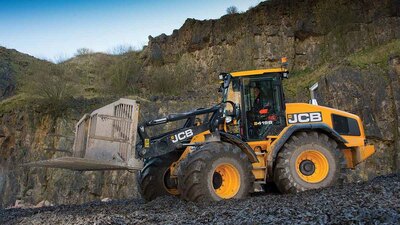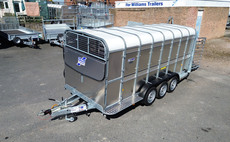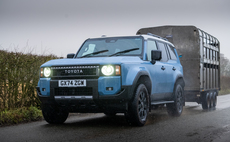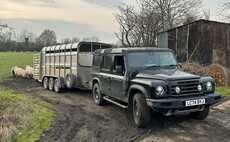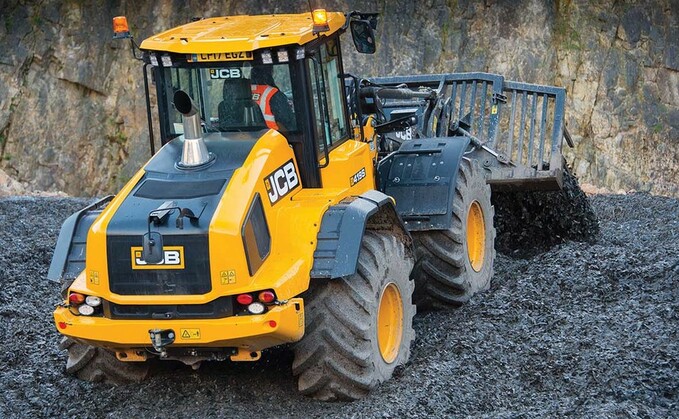
First previewed at the SIMA machinery show in Paris earlier this year, we catch up with JCB's new 419S wheeled loader for a test drive.
James Rickard takes to the wheel.
Armed with a new cab, a redesigned chassis and more power, JCB's new 419S is quite a departure from the old 418S which it replaces.
As the little brother to the self-proclaimed ‘king of the clamp', the 230hp, 14-tonne, 435S, the mid-model 183hp 419S should appeal to both medium sized contractors and large scale farmers.
To find out how much of an impact these latest changes have on the loader, we put two machines to work; one equipped with a toe tip bucket and the other a 3.7-metre-wide (12ft) folding fork.
Providing a scenario fit to try out these machines at a time of year when silaging is a distant memory, we introduced the brace of 419Ss to JCB's simulated silage clamp.
Made up of shredded tyres to a consistency very similar to maize, it delivered an ideal wintery proving ground for the machines, where loading trailers and building a clamp were the order of the day.
HYDRAULICS AND HANDLING
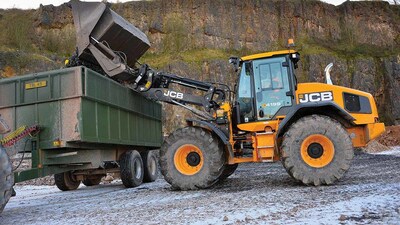
Physically, the 419S has gained a bit of bulk in all directions, particularly the chassis which has been heavily re-worked and lengthened by 300mm, improving the balance and ultimately the performance of the machine.
Much of the machine's weight is now shifted towards the rear, to such an extent that the firm has replaced the front metal mudguards with plastic ones.
The improvement in balance is noticeable, resulting in a more composed machine, both during handling and clamping duties. Traction is also boosted, allowing the machine to make the most of its power and operating weight.
Overall, hydraulic performance is good. For handling duties with short cycle times, loading trailers from a heap, for example, the machine needs little revs to make it work.
Taxing clamp work, however, it needs a bit more poking with stick to get its hydraulic juices flowing, especially when trying to feather out a load. This said, it is by no means a slouch.
To accommodate greater load ratings and allow larger tyres to be fitted, the 419S does away with JCB's own axles and employs heavier-duty ZF units, as used on the firm's 427 wheeled loader.
Slip differentials
As before, they get limited slip differentials as standard - ideal for clamp work where you want to maintain traction when turning.
A manual or automatic differential locking axle can be specified as an option, useful if using the machine mostly for materials handling where traction is not the priority.
Up to 750/65 R26 tyres can be fitted to the 419S, previously 620mm section tyres. If height is an issue or you want smaller tyres for greater clamp compaction, for example, tyres down to 500mm-wide can be fitted.
A smart feature at the rear of the machine is a hydraulically folding pickup hitch, rated to 10 tonnes.
When folded away, it provides an unhindered departure angle for the 419S to carry out clamp work without fear of ploughing concrete.
419S SPECIFICATIONS
- Engine: 6.7-litre, six-cylinder, Cummins
- Power: 183hp
- Torque: 841Nm
- Wheelbase: 2.85m
- Operating weight: 10,343kg
- Lift height with pallet forks: 3,509mm
- Straight tipping load: 6,769kg
- Full turn tipping load: 6,028kg
- Total fuel tank capacity with auxiliary tank: 250 litres
- AdBlue tank capacity: 23 litres
- Hydraulic flow rate: 180 litres/min via a variable displacement pump
- Availability: Now
- Retail price: £142,082
CAB AND CONTROLS
It is the cab which really sets the 419S apart from its predecessor, the 418S, and is a quantum leap away from the old 416.
Shared with several other models in the JCB wheeled loader family, the new CommandPlus cab gets more space and visibility.
The latter is particularly noticeable around the front of the cab, which has done away with lower solid panels and now sees full length glass extend to the floor.
Rear visibility is not too bad either, thanks to a sloping bonnet. To help this a rear view camera is fitted, which feeds an image to the in-cab terminal.
Sat in the high-backed operator's seat, which now features primary loader controls incorporated in its right-hand armrest, it really is an enjoyable place to work.
And seeing as one person will pretty much be driving this machine from May until October, and possibly beyond if loading muck spreaders, it needs to be too.
A ‘set and forget' steering column adjustment feature further helps comfort, and in-cab sound levels are remarkably quiet.
Features
All other machine features are now neatly located on the right-hand pillar, including transmission, constant pump and return to dig functions.
Further machine settings such as auxiliary hydraulic flow, boom suspension trigger speed and fan reverse intervals, can be accessed through the in-cab terminal, navigated simply by a scroll wheel.
The terminal also includes a help feature which describes all the machine's functions.
As an option, you can specify the ContractorPro package which features a carpet, a fridge, a deluxe half leather air suspension seat with heating/cooling function, a 360-degree LED lighting package, and most importantly of all, a chrome exhaust stack.
Cab pic
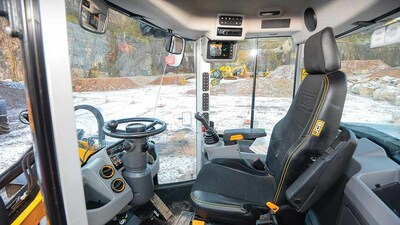
ENGINE AND TRANSMISSION
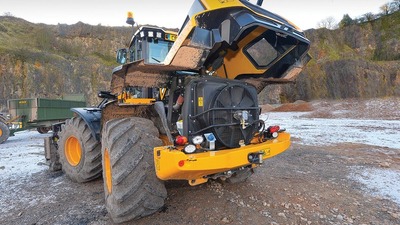
Power comes from a 6.7-litre Cummins. Enough said.
Over its predecessor, power is up 5 per cent, torque is up 5 per cent, and it now meets Stage 4 emissions levels via the use of selective catalytic reduction and a diesel oxidation catalyst only.
Like its big brother, the 419S boasts a healthy power to weight ratio; 17hp per tonne. This shows when climbing the clamp - a task the mid-sized mover was made for.
Aiding clamp climbing and boosting efficiency is the availability of torque lock up in all six of its gears.
Granted, torque lock-up in first gear might be a bit excessive, but it does make knocking the back wall out of a clamp a breeze.
Torque lock-up engagement is automatic, or it can be completely turned off which is useful for rolling the clamp.
Transmission can also be automated or operated in manual. In auto, the number of gears shifted through can be limited by selecting the upper most gear via the left-hand twist grip.
Accurate
For more accurate transmission control when carrying out handling tasks, a transmission disconnect feature can be engaged, which sees the transmission progressively disconnected as the brake pedal is pressed.
On the road, acceleration is swift, soon reaching its top speed of 48kph - enough to keep up with the silaging fleet.
Wrapped in the latest family styling is the engine bay, which sees improved control over the hydraulically-driven reverse fan.
Via the in-cab terminal, reversing intervals can be set at 15, 30 or 60 minutes, at which point the fan will reverse for about 10 seconds. Manual reversing is also possible.
A well-sealed engine bay prevents any unwanted dirt or debris from entering. And although aided by gas struts, the tight seal on the bonnet also makes lifting it open a job only for people who have had their Weetabix.
FG VERDICT
Like its big brother, the 419S is at home on the clamp. And while it is a decent materials handler, it is the pushing and climbing ability of the 419S which sets it apart from the competition.
This said, with the likes of Claas/Liebherr, Weidemann and Cat all launching equivalent-sized new models at the recent Agritechnica show, the 419S is up against some stiff competition.
Overall, the 419S is vastly improved compared to its predecessor in all departments, with the new cab the cherry on the icing.
Verdict pic
